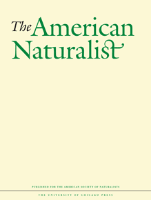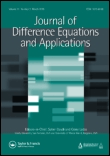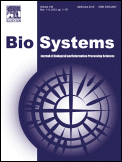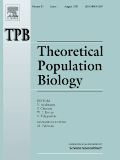
ACTA BIOTHEORETICA
metrics 2024
Connecting Agricultural Sciences, Mathematics, and Philosophy
Introduction
ACTA BIOTHEORETICA is a distinguished academic journal published by Springer, offering a vital platform for the dissemination of research within various interdisciplinary fields including Agricultural and Biological Sciences, Applied Mathematics, Biochemistry, Genetics and Molecular Biology, Environmental Science, and Philosophy. The journal, with its extensive history since its inception in 1935, holds a significant impact factor within its respective categories, ranking Q2 in Agricultural and Biological Sciences and Q1 in Philosophy as of 2023. Its archives, spanning from historical publications to contemporary studies, serve as a rich repository for scholars, professionals, and students dedicated to advancing knowledge in these areas. ACTA BIOTHEORETICA invites contributions that push the boundaries of theoretical exploration and practical application, with the aim of fostering an understanding that bridges science and philosophy. Although not open access, the journal maintains wide accessibility through its integrated digital platforms, enhancing the reach and impact of published work worldwide. Its central office located in Dordrecht, Netherlands further accentuates its international appeal and significance.
Metrics 2024
 0.32
0.32 1.40
1.40 1.20
1.20 39
39Metrics History
Rank 2024
Scopus
IF (Web Of Science)
JCI (Web Of Science)
Quartile History
Similar Journals

AMERICAN NATURALIST
Charting New Territories in Biological UnderstandingAMERICAN NATURALIST, published by University of Chicago Press, stands as a premier outlet for scholarly research in the fields of ecology, evolution, behavior, and systematics. With an impact factor that reflects its high citation rate, the journal has garnered a reputation within the academic community, evidenced by its placement in the Q1 category of its discipline in 2023 and an impressive Scopus rank of #135 out of 721 journals, positioning it in the 81st percentile for Agricultural and Biological Sciences. The journal, established in 1946, continues to uphold its commitment to advancing scientific knowledge through rigorous peer-reviewed articles. Researchers and professionals will find AMERICAN NATURALIST an essential resource, providing insights and discussions that illuminate complex biological phenomena, while fostering a deeper understanding of the natural world. As an essential reading for students and seasoned experts alike, its curated body of work encourages innovative thinking and exploration across an array of ecological and evolutionary topics.

BIOLOGICAL JOURNAL OF THE LINNEAN SOCIETY
Showcasing impactful research in biological sciences.BIOLOGICAL JOURNAL OF THE LINNEAN SOCIETY is a prestigious, peer-reviewed journal published by Oxford University Press that serves as a leading platform for original research in the fields of ecology, evolution, behavior, and systematics. With its ISSN of 0024-4066 and E-ISSN 1095-8312, this journal has maintained an impressive Q1 ranking in the latest Scopus statistics, which firmly positions it among the top tier of journals in its category (ranked #197 out of 721). Established in 1969, it covers a broad range of topics crucial for understanding biodiversity and the evolutionary processes shaping it, with its coverage extended until 2024. Though it does not operate under an open-access model, it ensures wide visibility and dissemination of impactful research findings. The journal is key for researchers, professionals, and students dedicated to advancing knowledge in biological sciences, fostering interdisciplinary collaboration, and addressing pressing ecological challenges.

JOURNAL OF DIFFERENCE EQUATIONS AND APPLICATIONS
Illuminating the forefront of algebra and applied analysis.The Journal of Difference Equations and Applications, published by Taylor & Francis Ltd, is a vital resource for researchers and professionals in the fields of algebra, analysis, and applied mathematics. With its ISSN 1023-6198 and E-ISSN 1563-5120, this esteemed journal aims to foster the development and understanding of difference equations and their applications across various mathematical contexts. Since its inception in 1995, the journal has consistently ranked within the Q2 category for Algebra and Number Theory, Analysis, and Applied Mathematics, showcasing its high-impact contributions to the field. The journal is particularly noteworthy for its rigorous peer-review process and commitment to advancing mathematical knowledge and research. Although it is not open access, it remains accessible through various institutional subscriptions. With a focus on innovative methodologies and interdisciplinary approaches, the Journal of Difference Equations and Applications is essential reading for those looking to stay at the forefront of mathematical research and applications.

PHYSICAL BIOLOGY
Connecting Disciplines for Groundbreaking DiscoveriesPHYSICAL BIOLOGY is a prominent journal published by IOP Publishing Ltd, focusing on the interdisciplinary field of biophysics, cell biology, molecular biology, and structural biology. Established in 2004, this journal has quickly made its mark in the academic community, currently ranking in the Q2 category in Biophysics and Q3 in Cell, Molecular, and Structural Biology as of 2023. With an ISSN of 1478-3967 and E-ISSN 1478-3975, it serves as a vital platform for disseminating groundbreaking research that bridges physical principles with biological systems. While currently not providing Open Access options, the journal offers access to a wealth of knowledge crucial for researchers, professionals, and students alike who are eager to explore the intricacies of living organisms through a physical lens. Situated in the United Kingdom, PHYSICAL BIOLOGY emphasizes the importance of multiscale approaches and innovative techniques, making it an essential resource for those working at the intersection of physics and biology.

BIOSYSTEMS
Unveiling the quantitative secrets of life through research.BIOSYSTEMS is a prestigious academic journal published by Elsevier Science Ltd, dedicated to the interdisciplinary fields of applied mathematics, biochemistry, genetics, molecular biology, medicine, modeling and simulation, and statistics and probability. Established in 1967, this journal has carved a niche in presenting innovative research that bridges theoretical and practical aspects of biological systems, making it essential reading for researchers, professionals, and students alike. With a robust impact factor and a Q3 category ranking across various fields, BIOSYSTEMS is recognized for its contributions to advancing scientific knowledge and fostering collaborations among disciplines. The journal's rigorous peer-review process ensures high-quality and impactful articles that address complex biological challenges through quantitative and qualitative methods. As a vital resource for the academic community, BIOSYSTEMS invites submissions that enhance understanding of biosystem processes, enabling readers to stay at the forefront of research trends and applications.

AIMS Biophysics
Innovating biophysics research for a deeper understanding of biology.AIMS Biophysics, published by the American Institute of Mathematical Sciences (AIMS), is an esteemed open-access journal dedicated to advancing the fields of biophysics, biochemistry, molecular biology, and structural biology. Launched in 2014, this journal provides a platform for researchers and professionals to disseminate high-quality research findings that contribute to the understanding of complex biological systems at the molecular level. With an ISSN of 2377-9098, AIMS Biophysics is indexed in Scopus, where it ranks in the fourth quartile across several categories, reflecting its commitment to addressing important issues within the scientific community. The journal aims to foster interdisciplinary collaboration and innovation through the publication of original research, reviews, and methodologies that advance the field. The open-access model ensures that cutting-edge research is freely available, promoting global access to scientific knowledge and enhancing visibility for authors. Nestled in the vibrant scientific landscape of the United States, AIMS Biophysics is poised to impact the evolving discourse in biophysics and related areas as it continues through its convergence period from 2014 to 2024.

THEORETICAL POPULATION BIOLOGY
Illuminating the Path of Population DynamicsTHEORETICAL POPULATION BIOLOGY is a leading academic journal published by Academic Press Inc. Elsevier Science, dedicated to advancing the understanding of population biology through theoretical frameworks and models. With an ISSN of 0040-5809 and an E-ISSN of 1096-0325, this journal has been a cornerstone in its field since its inception in 1970. Recognized for its significant contributions to the study of ecological and evolutionary dynamics, it currently holds a Q2 ranking in the Ecology, Evolution, Behavior and Systematics category as per the 2023 category quartiles. Researchers and professionals alike appreciate its role in disseminating impactful findings, as reflected in its percentile ranking of the 51st in Scopus for the Agricultural and Biological Sciences field. While the journal is not open access, it remains a vital resource for those looking to deepen their knowledge and research in theoretical approaches to population biology, making it an essential read for students, aspiring scientists, and veteran researchers seeking to engage with cutting-edge theoretical developments.

Theoretical Ecology
Pioneering new frontiers in ecological modeling.Theoretical Ecology, published by SPRINGER HEIDELBERG, is a premier journal in the field of ecological modeling and theory, exemplifying the intersection of rigorous quantitative analysis and ecological understanding. With its ISSN 1874-1738 and E-ISSN 1874-1746, this journal has been a valuable resource for researchers since its inception in 2008, with a commitment to publish cutting-edge research until 2024. The journal's 2023 category quartiles demonstrate its impact, ranking Q3 in Ecological Modeling and Q2 in Ecology, reflecting its significance within the academic community. Furthermore, its Scopus rankings position it among the top tier of environmental science journals, ranking #181/461 in Ecology and #21/41 in Ecological Modeling. While the journal does not offer open access, it is an essential publication for those looking to deepen their understanding of theoretical frameworks that drive ecological research and practice. By providing a platform for innovative theories and models, Theoretical Ecology plays a crucial role in shaping future ecological studies and informing policy decisions in environmental management.

Annual Review of Ecology Evolution and Systematics
Illuminating the Path of Ecological and Evolutionary ResearchThe Annual Review of Ecology, Evolution, and Systematics, published by Annual Reviews, is a leading academic journal dedicated to advancing the understanding of ecological and evolutionary processes. With a commendable impact factor and impressive rankings—9th in both the Ecology, Evolution, Behavior and Systematics category and the Environmental Science category—this journal is recognized for its rigorous peer-reviewed articles that synthesize research findings across a wide range of topics within the fields of ecology and evolutionary biology. Established in 2003, this annual publication aims to provide researchers, professionals, and students with comprehensive insights into the latest developments and trends within these dynamic disciplines. By facilitating access to high-quality scholarly articles, the Annual Review of Ecology, Evolution, and Systematics continues to play a crucial role in fostering scientific discourse and discovery.

BULLETIN OF MATHEMATICAL BIOLOGY
Bridging Disciplines through Mathematical ExplorationBulletin of Mathematical Biology, published by Springer, is a premier journal dedicated to advancing the field of mathematical biology. With an ISSN of 0092-8240 and an E-ISSN of 1522-9602, this journal has been at the forefront of interdisciplinary research since its inception in 1973, continuing to deliver high-quality contributions through 2024. Operating without an open-access model, the journal maintains robust academic rigor, reflected in its category quartiles for 2023, which positions it in Q1 and Q2 across several relevant fields, including Agricultural and Biological Sciences, Biochemistry, Genetics, and Mathematics, among others. Its impressive Scopus ranks further underscore its significance, placing it in the top tier of journals in general mathematics and agricultural sciences. Researchers, professionals, and students looking to deepen their understanding and contribute to the evolving landscape of mathematical biology will find this journal an essential resource for contemporary studies and advancements in the field.